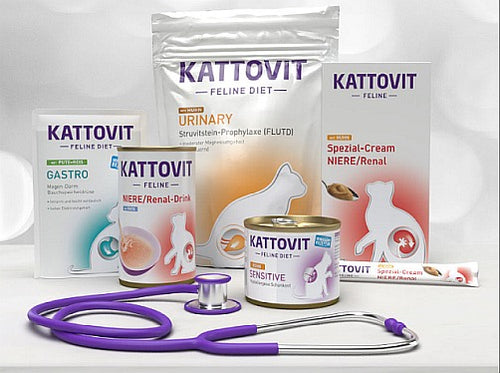Is your cat constantly scratching itself and seems restless? Then fleas may have settled into your cat's fur. A flea infestation is extremely unpleasant for cats and can have serious consequences: on the one hand, fleas can cause dangerous secondary diseases in cats, and on the other hand, they can also infest other animals and even people in the household. Once the parasites have made it into your home, it is not that easy to get rid of them. Find out here how you can recognize fleas on your cat, combat the infestation, treat secondary diseases and prevent a new flea infestation.
Detecting Fleas on Cats
A flea infestation in cats can usually be identified by the following Recognize symptoms :
- intense scratching of the skin
- restless behavior
- particularly intensive coat care
- reddish spots on the skin
- rash and eczema on the skin
The so-called cat flea (technical term Ctenocephalides felis ) is the most common flea found on cats. However, fleas can also jump from other hosts to cats, such as dog or hedgehog fleas. Conversely, cat fleas can also find a new host and jump to other animals or people living in the household.
Cat fleas are usually reddish-brown and are between 1.5 to 4 mm in size . In theory, they are visible to the human eye - but in practice this is quite difficult in a cat's thick fur. If you suspect that your cat is suffering from a flea infestation based on the symptoms mentioned above, the best way to identify the fleas is as follows:
- Comb your cat’s fur with a flea comb carefully and wipe the comb on a paper towel. Alternatively, you can shake your cat's fur over a newspaper or cloth without a flea comb.
- If there are now small, brown to black crumbs , it is most likely a flea infestation. The crumbs are the Flea droppings that get stuck in the cat's fur. If you now moisten the cloth, the crumbs should turn reddish - this is due to the blood residue in the flea droppings.
- In addition, see if puncture sites of the blood-sucking parasites. These are often located in a line close to each other, as the fleas test the blood flow in different places - flea bites next to each other are therefore also called a " flea trail ".
If your cat is itchy and there are flea droppings in its fur and flea bites on your cat's skin, it's clear that the cat fleas have taken hold. Both your cat and your home now need intensive treatment. If the flea infestation remains undetected and untreated for a long time, or if the infestation is particularly severe, this can have serious consequences.
[Aufbaukur]
consequences of flea infestation
Cat fleas can have a very negative impact on your pet's health and cause secondary illnesses. These include:
- anemia and iron deficiency
- flea saliva allergy
- parasite infestation
- transmission of bacteria and viruses
anemia and iron deficiency
Kittens in particular, but also adult cats that suffer from a long-term or severe flea infestation, are at risk of anemia in combination with iron deficiency due to the blood-sucking flea bites. Affected animals are often tired , listless , have pale mucous membranes and an increased pulse. Usually also Breathing difficulties occur. A veterinarian should intervene as soon as possible, administer supportive medication and, if necessary, carry out a blood transfusion. If the anemia progresses too far, it could become life-threatening.
flea saliva allergy
Some cats are allergic to certain protein components in the saliva of fleas. The so-called flea saliva allergy or flea saliva dermatitis can occur as soon as the first flea bite and can cause additional problems for your cat. In addition to the itching that is characteristic of flea infestation, cats with a flea saliva allergy react particularly restlessly. They try to relieve the itching by intensive licking and scratching. This often results in hair loss and bald spots . The allergy can also cause inflammation of the skin around the bite sites, causing blisters and crusts to form.
parasite infestation
Like ticks and mites, fleas are ectoparasites that attack a host from the outside and suck its blood. At the same time, however, cat fleas can also be carriers of endoparasites - parasites that attack a host from the inside. These include tapeworms, for example. If a cat swallows fleas while grooming its fur, it will often subsequently become infected with cucumber seed tapeworms or other worms in the intestines.
transmission of bacteria and viruses
In addition, fleas can transmit numerous bacteria and viruses. These are often Listeria, Rickettsia or Bartonellonia, for example. The latter can also be transmitted from cats to humans through scratches and cause the disease Bartonellosis. Bartonellosis, better known as cat scratch disease, causes flu-like symptoms in humans for up to two months after infection and can be very long-lasting. Healthy cats with Bartonellosis rarely show symptoms. There is a particular risk for cats with weakened immune systems, which, in addition to fever under Inflammations in the mouth , eyes and heart. The transmission of dangerous viral infections such as feline leukosis, feline AIDS and Cat flu is caused by cat fleas.
How do indoor cats and outdoor cats get fleas?
A flea infestation is unpleasant, involves risks and should be avoided if possible. But how do indoor cats and outdoor cats get fleas in the first place? Outdoor cats are at relatively high risk of catching the blood-sucking creatures. In the wild, they come across numerous other cats and other animals from which fleas can jump to them. Indoor cats that do not leave the house are by no means immune to fleas. Both other pets and humans can bring fleas into the home, either as live animals or in their developmental stage as larvae or pupae. There, the parasites look for a new host and jump to the cat. For this reason, cats can be infested not only by cat fleas, but also by typical dog or hedgehog fleas, for example.
What helps against fleas?
Fighting fleas on animals and in the home is so difficult because flea infestations occur in different stages of development. On average, only 5% of infestations are adult fleas - 95%, however, are eggs, larvae and pupae. An adult female flea can lay up to 30 eggs a day. Within one to two days, the eggs develop into larvae, which then pupate. After three to five weeks, the fleas finally hatch from the pupae.
So if you only fight the adult fleas on your cat but do not clean the environment sufficiently, the fleas will probably return after a few days or weeks because a new generation has grown. Fighting the flea infestation must therefore be done in two steps: firstly, you need to treat the infested cat and secondly, you need to thoroughly clean the environment and your entire home.
Combating and preventing flea infestation in cats
First of all, you should treat a flea infestation in your cat as quickly as possible so that the parasites have as little time as possible to spread and multiply. There are tablets, sprays and spot-on solutions to prevent the specific infestation of the cat's fur. Spot-on preparations are usually dripped onto the cat's neck and enter the cat's bloodstream. The agent reaches the blood-sucking parasites directly via the blood and eliminates them. To get rid of eggs, larvae and pupae, you should regularly comb your cat with a flea comb and clean its fur - special flea shampoos may also be an option. It is best to ask your vet for advice on suitable medication.
The same applies if your cat is allergic to flea saliva. The vet can recommend medication and ointments to combat the extreme itching and fleas, as well as to reduce skin inflammation, which are also suitable for allergies and are well tolerated.
Furthermore, you should treat not only the affected cat, but also all other cats and pets in the household, such as dogs or rabbits, with anti-flea medication. Even if the animals do not yet show any signs of flea infestation, this may already have happened or may happen in the near future due to the eggs and larvae present in the environment. The flea medication also has a preventative effect and helps to keep fleas away from your animals.
Another important tip: Don’t just fight the flea infestation, but Deworm your cat too. Since fleas often transmit other parasites such as worms, such treatment is essential in the event of a flea infestation in order to protect your cat's health. There are even combination products specifically for this purpose that work against both fleas and other parasites.
Getting cat fleas out of your apartment
In addition to the cat, the entire apartment must also be treated and cleaned. This is because flea eggs, larvae and pupae are only a few millimeters in size and can spread throughout the entire household. You should pay particular attention to your furry friend's favorite places to stay. The closest surroundings usually include the litter box, the cat bed, upholstered furniture such as sofas and armchairs, carpets and your own bed.
You can take the following measures to get rid of fleas and their offspring from your home:
- Clean all surfaces thoroughly with household cleaner.
- Vacuum the floor and suitable surfaces with the vacuum cleaner and then dispose of the vacuum cleaner bag - otherwise there is a risk that new fleas will emerge from the sucked-up larvae and pupae and jump out of the vacuum cleaner.
- After vacuuming, you should also thoroughly wipe and clean the floor and all cracks.
- Wash potentially contaminated textiles at a minimum of 60 degrees.
- Fabrics and objects that cannot be washed can be frozen in the freezer at -18 degrees or colder for at least two days.
- Special room sprays can help to neutralize all parasites in the environment.
If these measures are of no use and you cannot get rid of the cat fleas on your animals and in your home in the long term, professional pest control may be the only solution. Using foggers or nebulizers, anti-flea medication can be sprayed into the home, which effectively combats the parasites. During this time, neither you nor your cats or other animals should be in the home.
Restore your cat's health after flea infestation
Is your cat very weak after a flea infestation – perhaps because other parasites, bacteria or viruses have been transmitted? After the fleas, worms and other Diseases , you should give your velvet paw plenty of rest and care. A flea infestation is very unpleasant and causes a lot of stress. Give your furry friend enough space and time to recover. If it is also physically exhausted, special food may help it to recover. Our KATTOVIT Aufbaukur provides your cat with an extra portion of energy after a massive parasite infestation. The food is easy to digest and tastes good even to picky cats, so your furry friend can get back on its feet as quickly as possible.









